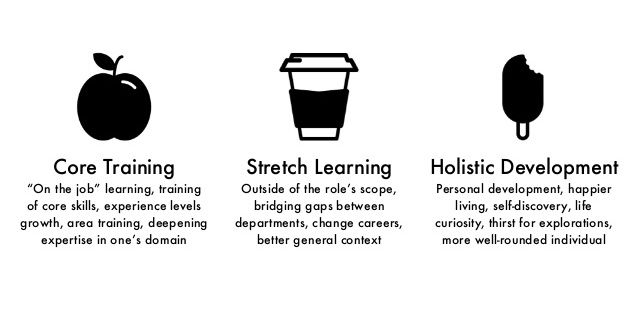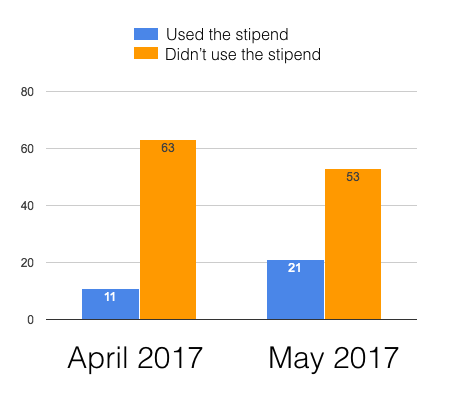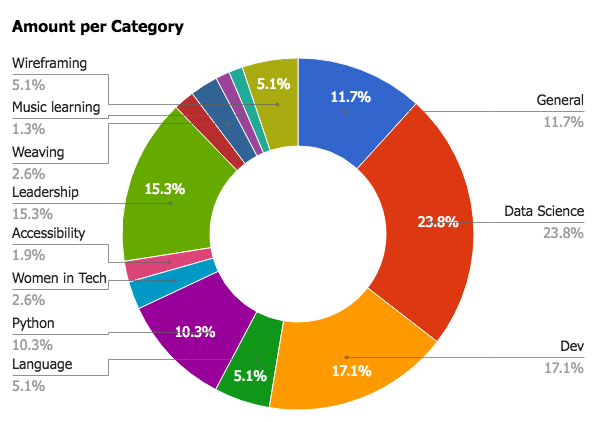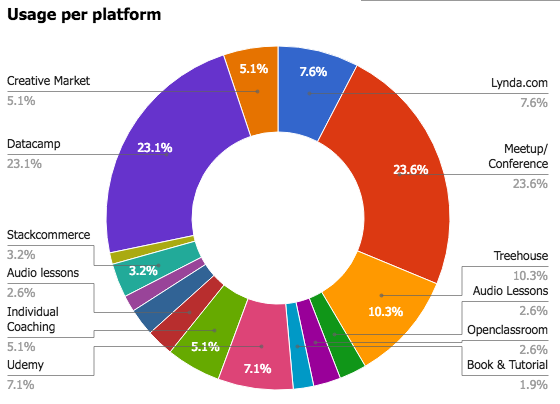One of the 10 Buffer values we aspire to is constant self-improvement, which includes learning new skills, new information, new everything. Little did we know how much there was to learn about learning itself!
Recently, we’ve specifically sought out even more ways to encourage learning for our whole team at Buffer, with projects spearheaded by our People team and our teammate Deborah.
The main question she’s been asking is: How can we help encourage a culture of learning on our team?
That’s where learning and development comes in.
The concept of learning and development is “the formal, ongoing efforts that are made within an organization to improve the performance of its employees.” (KashmirObserver) Learning and development can take on various forms: coaching, classes, conferences, training, or many other things. Here’s how we’ve started to implement it in a lean way at Buffer.
What learning and development looks like at Buffer
There are two things top of mind for us when we’re thinking about learning and development:
- We want something that can be accessible to the entire team, not just one part of the Buffer team, and we don’t want to exclude teammates who might not be able to attend a class or conference.
- We’re working with a very small budget, so it needs to be affordable.
One perk that we have at Buffer now related to learning and development, is our Kindle perk where all employees get a Kindle when they start at Buffer and free Kindle books whenever they want them. (In 2016, the team read 1,366 books on their Kindles, that was 17 books per person.)
The unlimited Kindle and Audible perk is an incredible help in the team’s self-improvement goals and in growing new skills.
At this point in Buffer’s journey, we felt ready to add to that perk (without replacing the Kindle perk) and start investing further into resources that could help folks learn from different mediums like tutorials, online courses, or real-life courses.
With that in mind, Deborah implemented a Learning and Development Stipend of $20 per month, per teammate. That works out to about $18,000 for one entire year (assuming everyone uses the stipend every month.)
A stipend was the easiest and most widespread learning perk that we could immediately kick off for everyone at Buffer. Many of our Buffer teammates are already self-starters and just needed a small amount of encouragement — or a small reminder — to focus on learning.
How the stipend works
Does it need to be related to a teammates role?
It doesn’t! Each teammate can choose to spend $20 on learning whatever they’d like. We do this because we want to encourage all types of learning: core training, stretch learning, and holistic development. Here’s a bit more on each of those:

How do conferences fit in?
Bufferoos love conferences and there are so many amazing ones across many industries. While we’d all love to attend as many as possible, conferences do tend to be quite expensive and we’re not in a place to allocate a large budget to this (just yet!).
Can several months of the stipend be used at once?
Yes! If the courses or classes go beyond the $20 stipend, a person can use several months of their stipend – up to $180 for 2017 (since we kicked off this perk in April).
Why $20?
Most teammates can already afford to spend $20 a month on learning development if they’d like. The goal for us with the stipend wasn’t to give them a huge amount of money but to let them know that this is something we want to support at Buffer. The total investment for Buffer annually is $18,000.
So far the feedback we’ve gotten from our team is that even though the stipend is a small amount, it really got people’s wheels turning on what to learn next.
Here are a few examples of resources that this stipend was calculated against and could cover initially:
- Core Training ?
- Stretch Learning ?
- Holistic Development ?
| Name | Type | Price Tag | |
|---|---|---|---|
| Highbrow | 10 day email courses (5 min/day readings) | $7/month (if paid monthly) or $4/month (if paid annually) | ? ? |
| Blinkist | Non-fiction Book summaries | $49.99 annually for Blinkist Plus / $79.99 annually for Blinkist Premium | ? ? |
| Coursera | Courses of all types (partnerships with Universities) | $45/month average for technical courses (some are free) | ? ? |
| Skillshare | Unlimited access to over 14,000 classes (all types) Pro version includes offline access & no ads. Ex: Creative, Business, Technology, Lifestyle (Languages, Crafts etc.) | $18/month (if paid monthly) or 10$ if paid annually | ? ? ? |
| Treehouse | Coding courses | $25 per month (basic) | ? ? |
| Udacity | | Nanodegrees in partnerships with businesses & free courses Ex: Robotics, Digital Marketing, Predictive Analytics for Business, VR Developer, Artificial Intelligence, Android basics, Machine Learning Engineer, Intro to Programming, Full Stack, Front-end, iOS, Data Analyst | $299/month (7 day trial) for NanoDegrees | ? ? |
| Udemy | Courses of all types (from psychology to woodworking) | Not a subscription, between $15 and $200 | ? ? |
| CodeAcademy | Coding classes (pro version includes a personalised Learning Plan, access to quizzes and real world projects, | $19.99/month for the Pro version | ? ? |
| General Assembly | Part time courses and full time courses (on site) or online classes and workshops (Design, Data, Social Media, Coding, running a podcast etc.) | $235 for Short Courses, $1,250 for part-time courses | ? ? |
| Khan Academy | Short courses in Science & engineering, Computing, Computer programming, Computer science, Arts & humanities, Grammar, Music, History (art, US, world), Economics & finance, Finance & capital markets, Entrepreneurship | Free courses (but limited in depth/length) | ? ? ? |
Of course, people don’t need to choose from this list. These are just a few examples. ?
The number of Buffer teammates who are using this perk is…
21 out of 74 total employees, or 28%, in May. We’re quite excited at this initial jump and can’t wait to keep growing this number.
Here’s what the usage looks like since April 2017 (when we first launched the perk.)

How are Bufferoos using this perk?
Since the $20 doesn’t need to be directly related to someone’s role, we were quite keen to see how this stipend might get used.
Here are the categories in which people are spending the stipend:

- 5.1% – Wireframing
- 5.1% – Language
- 10.3% – Python
- 11.7% – General
- 15.3% – Leadership
- 17.1% – Development
- 23.8% – Data Science
Everything from learning music, weaving, or a new language, to data science and web development.
Here are the methods that people are using for learning, too:

- 4.8% – Datacamp
- 4.8% – Highbrow
- 4.8% – Individual Coaching
- 4.8% – Skillshare
- 4.8% – Book & Tutorial
- 4.8% – Openclassroom
- 4.8% – Audio Lessons
- 9.5% – Udemy
- 9.5% – Lynda
- 14.3% – Treehouse
- 19% – Meetup / Conference
Learn What We’re Learning!
These are the top resources we’re using our learning and development stipend on at Buffer, feel free to check them out and see if there are any courses you’re keen to get learning.
Udemy – Online courses with a range of topics
Skillshare – Online courses for creators
Highbrow – Get 5-minute lessons delivered to your inbox every morning
Datacamp – Learn Data Science online
Lynda – Online courses, classes, training, and tutorials
Treehouse – Learn Web Design, Coding, and more
Other learning initiatives we’re working on
We have a few other smaller initiatives on the go, too. These are all a result of Deb discovering from other companies that learning and development is most effective when it’s paired with a way that employees are given time to focus on it.
The Helpboard
A living document where any teammate can post what kind of learning they need help with (ie. writing javascript) and another teammate can jump in to assist. We’re also using it to share who on the team can help with which skills to make it easy to learn from and help each other.
Learning Groups
We’re experimenting with putting groups together of people who are all learning the same thing. Right now we regularly have a “Learning to code” group that is getting together.
Professional Development Fridays
Our Happiness Team Lead, Åsa, put together a structure so that the Happiness Heroes can take a half day for professional development on Fridays when their tasks are all finished for the week.
How other companies do learning and development
We’re certainly not the first tech company to have a focus on learning.
Zappos
We’ve long admired how Zappos treats their team. For learning, Zappos created a department specifically for employee development called ZapposU in 2008. Here’s more from their blog:
The concept of ZapposU started with the launch of two classes, Project Culture and Communication. The goal was to offer classes that focused on helping employees develop soft skills and characteristics that a strong leader would embody. Soon classes like Finance and Public Speaking followed. Before long, departments were requesting training tools and department-specific classes. “It really evolved organically,” says Diana Guido, ZapposU Trainer. Department-specific classes are taught by department experts on those topics and often supplement certain progression paths.
Slack
Right on their hiring page, Slack explains that employees receive $500 annually towards a personal development opportunity of their choice and $2000 annually for professional development. That’s huge investment on Slack’s part and really helps frame how much they prioritize employee learning and development.
Shopify
Shopify also has learning and development front and center on their hiring page. Touting everything from learning budgets to one-on-one coaching, there are many ways a company can encourage development.
Your personal growth is important to us, and we’ll give you everything you need to make it happen: learning budgets, mentorship opportunities, one-on-one coaching, skill development workshops, you name it. We encourage you to experiment, take risks, and pursue the things you care about. And if you make a mistake? That’s ok – learn from it, and share your experience with the team.
Over to you!
We’d love to learn (?) what you think!
- How would you spend $20 a month? (All ideas welcome!)
- Does your company do learning and development? If so, what does it look like?
- What kind of learning do you focus on?
Share in the comments below. ?
Try Buffer for free
190,000+ creators, small businesses, and marketers use Buffer to grow their audiences every month.




